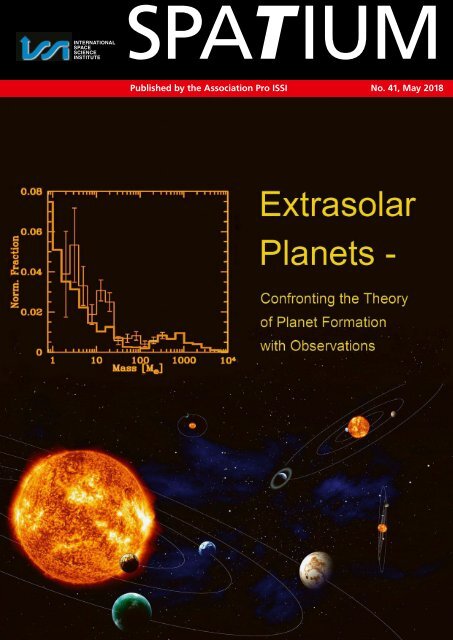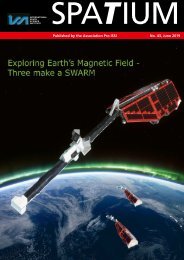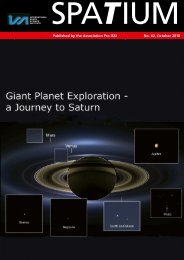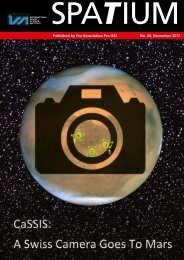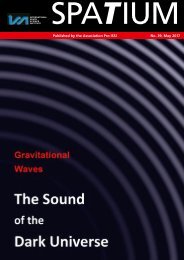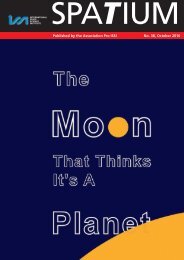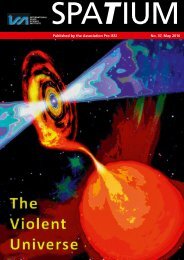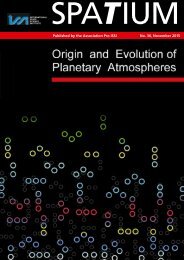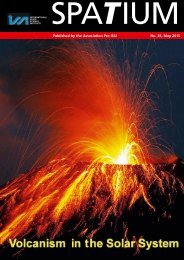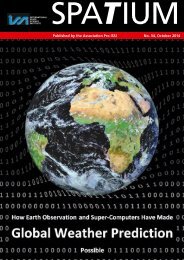Extrasolar Planets - Confronting the Theory of Planet Formation with Observations
Summary of the Pro ISSI talk by Christoph Mordasini (SPATIUM Volume 41)
Summary of the Pro ISSI talk by Christoph Mordasini (SPATIUM Volume 41)
You also want an ePaper? Increase the reach of your titles
YUMPU automatically turns print PDFs into web optimized ePapers that Google loves.
INTERNATIONAL<br />
SPACE<br />
SCIENCE<br />
INSTITUTE<br />
SPATIUM<br />
Published by <strong>the</strong> Association Pro ISSI No. 41, May 2018
Editorial<br />
<strong>Extrasolar</strong> planets – why should we<br />
care? Simple answer … first <strong>of</strong> all,<br />
a planet in general is an interesting<br />
place, we should best know, we inhabit<br />
one. The Universe is filled<br />
<strong>with</strong> planetary systems, and for<br />
over two decades now increasingly<br />
more <strong>of</strong> <strong>the</strong>m are being discovered.<br />
This is nei<strong>the</strong>r a surprise nor anything<br />
to start being bored <strong>of</strong>, in<br />
fact every new planet helps to improve<br />
our knowledge and also to<br />
push <strong>the</strong> limits <strong>of</strong> what we want to<br />
learn. This exactly is <strong>the</strong> implication<br />
given by <strong>the</strong> title <strong>of</strong> <strong>the</strong> talk:<br />
“A Laboratory to Confront <strong>the</strong><br />
<strong>Theory</strong> <strong>of</strong> <strong>Planet</strong> <strong>Formation</strong> <strong>with</strong><br />
<strong>Observations</strong>”.<br />
However, almost <strong>with</strong> each new<br />
discovery, <strong>the</strong>re is at least one new<br />
question that is opened up as well.<br />
The more we observe, <strong>the</strong> more<br />
we realise that <strong>the</strong>re is still much<br />
more to learn, in fact, <strong>the</strong>re are a<br />
huge number <strong>of</strong> open questions in<br />
planet formation.<br />
Still, <strong>the</strong> search for extrasolar planets<br />
is a demanding undertaking and<br />
needs extremely precise instrumentation.<br />
It is understandably<br />
hard to detect a light signal <strong>of</strong> a<br />
small object next to a million or<br />
billion times brighter one, its host<br />
star. Similarly, it is not easy to identify<br />
a tiny dark spot on a bright object<br />
or a minuscule shift in a star’s<br />
spectrum due to <strong>the</strong> presence <strong>of</strong><br />
one or more companions.<br />
As instrumentation techniques are<br />
progressing, this fosters new models<br />
to be developed to explain what<br />
has been observed. Of course, <strong>the</strong><br />
ultimate test for all new <strong>the</strong>ories<br />
are <strong>the</strong>n <strong>the</strong> observations again,<br />
and a fruitful combination <strong>of</strong> models<br />
and data can lead to better understanding<br />
<strong>of</strong> our environment.<br />
The sheer number <strong>of</strong> planets now<br />
has made statistics an appropriate<br />
tool to do exactly that.<br />
The successive extension <strong>of</strong> our<br />
laboratory space from <strong>the</strong> home lab<br />
Earth to <strong>the</strong> neighbour lab Solar<br />
System to remote parts is still ongoing,<br />
and we are in for surprises.<br />
Discovering new worlds far outside<br />
our own and noting <strong>the</strong>ir vast<br />
diversity does not only help in understanding<br />
basic physical processes<br />
but also in realising that <strong>the</strong><br />
very system we have <strong>the</strong> chance to<br />
inhabit is special among all <strong>the</strong><br />
planetary systems discovered so far.<br />
The present text is based on a lecture<br />
by Pr<strong>of</strong>. Christoph Mordasini<br />
in <strong>the</strong> Pro ISSI seminar series. It<br />
has been edited and arranged <strong>with</strong><br />
valuable input from Pr<strong>of</strong>. M.C.E.<br />
Huber and Dr. H. Schlaepfer.<br />
Anuschka Pauluhn<br />
Mönthal, February 2018<br />
Impressum<br />
ISSN 2297–5888 (Print)<br />
ISSN 2297–590X (Online)<br />
Spatium<br />
Published by <strong>the</strong><br />
Association Pro ISSI<br />
Association Pro ISSI<br />
Hallerstrasse 6, CH-3012 Bern<br />
Phone +41 (0)31 631 48 96<br />
see<br />
www.issibern.ch/pro-issi.html<br />
for <strong>the</strong> whole Spatium series<br />
President<br />
Pr<strong>of</strong>. Adrian Jäggi,<br />
University <strong>of</strong> Bern<br />
Layout and Publisher<br />
Dr. Hansjörg Schlaepfer<br />
CH-6614 Brissago<br />
Printing<br />
Stämpf li AG<br />
CH-3001 Bern<br />
Title Caption<br />
Artist’s view on how common<br />
planets are around <strong>the</strong> stars in <strong>the</strong><br />
Milky Way – <strong>the</strong> rule ra<strong>the</strong>r than<br />
<strong>the</strong> exception. (Credit: ESA, C.<br />
Carreau).<br />
The inset shows <strong>the</strong> plot <strong>of</strong> a computed<br />
and a measured planetary<br />
mass distribution, from Benz et al.<br />
(2014).<br />
SPATIUM 41 2
<strong>Extrasolar</strong> <strong><strong>Planet</strong>s</strong><br />
<strong>Confronting</strong> <strong>the</strong> <strong>Theory</strong> <strong>of</strong> <strong>Planet</strong> <strong>Formation</strong> <strong>with</strong> <strong>Observations</strong> 1<br />
by Pr<strong>of</strong>. Christoph Mordasini, University <strong>of</strong> Bern<br />
Introduction<br />
Naturally, our understanding <strong>of</strong><br />
planets has so far been swayed by<br />
<strong>the</strong> Solar System planets that have<br />
been observed for ages. These have<br />
shaped <strong>the</strong>ories that can now be<br />
tested against increasing numbers<br />
<strong>of</strong> examples from systems that are<br />
very different from ours. New systems,<br />
some <strong>with</strong> new and unexpected<br />
properties are forcing us to<br />
adapt and re-think our <strong>the</strong>ories, as<br />
already anticipated some years ago,<br />
just shortly after <strong>the</strong> first extrasolar<br />
planetary systems had been discovered<br />
2 . Every new discovery is<br />
checked – does it fit into our models?<br />
If so, fine, one more for <strong>the</strong><br />
current <strong>the</strong>ories; if not, what is<br />
wrong – faulty observation, flaws<br />
in <strong>the</strong> measurement, or a completely<br />
new feature that needs more<br />
explanation and study. The goal is<br />
not “to detect for <strong>the</strong> detection’s<br />
sake”, but to improve our know l-<br />
edge, our <strong>the</strong>ory, our understanding<br />
<strong>of</strong> <strong>the</strong> world we live in.<br />
The exoplanet detection count<br />
jumped up after 1995: Michel<br />
Mayor and Didier Queloz had detected<br />
<strong>the</strong> gas giant planet 51 Pegasi<br />
b 3 , which orbits a ra<strong>the</strong>r ordinary<br />
G-type main-sequence star, not<br />
too much different from our Sun<br />
and thus had found a ra<strong>the</strong>r big<br />
planet <strong>of</strong> half <strong>the</strong> mass <strong>of</strong> Jupiter<br />
<strong>with</strong> an orbital period <strong>of</strong> only 4.23<br />
days. Following this discovery <strong>of</strong> a<br />
gas giant in a short-period orbit<br />
close to its host star, astronomers<br />
now looked as a matter <strong>of</strong> course<br />
for more unexpected types <strong>of</strong><br />
companions!<br />
Several branches can be followed<br />
in planetary research – from <strong>the</strong><br />
exoplanets’ orbital dynamics to<br />
Figure 1: The Solar System planets, toge<strong>the</strong>r <strong>with</strong> some dwarf planets located beyond Neptune’s orbit in <strong>the</strong> Kuiper belt.<br />
Sizes to scale, not distances. Credit: The International Astronomical Union/Martin Kornmesser.<br />
1<br />
The current text is a summary <strong>of</strong> Pr<strong>of</strong>. Mordasini’s talk for <strong>the</strong> Pro ISSI audience on 15 March 2017.<br />
It was drafted by Dr. Anuschka Pauluhn and revised by Pr<strong>of</strong>. Mordasini.<br />
2<br />
See Spatium 6 by W. Benz (2000).<br />
3<br />
The <strong>of</strong>ficial name <strong>of</strong> an exoplanet is a combination <strong>of</strong> <strong>the</strong> parent star’s name and a lower-case letter, in <strong>the</strong> order <strong>of</strong><br />
detection. The first planet <strong>of</strong> <strong>the</strong> system is denoted “b”, <strong>the</strong> second “c”, etc.<br />
SPATIUM 41 3
<strong>the</strong>ir structure and composition,<br />
and in particular also that <strong>of</strong> <strong>the</strong>ir<br />
atmospheres 4 . Of course, all <strong>the</strong>se<br />
studies are closely related, and <strong>of</strong><br />
central interest is <strong>the</strong> way planets<br />
are evolving – following <strong>the</strong>ir entire<br />
life cycle from formation to<br />
later stages in <strong>the</strong>ir career in a planetary<br />
system like in ours, for<br />
example.<br />
However, observing <strong>the</strong>m is not<br />
simple in most cases. Stars, on <strong>the</strong><br />
o<strong>the</strong>r hand, are much easier to<br />
observe; <strong>the</strong>y outshine any planet<br />
around <strong>the</strong>m. Indeed, a large part<br />
<strong>of</strong> <strong>the</strong>ir evolution has been reconstructed<br />
a long time ago. Ordering<br />
<strong>the</strong>m according to <strong>the</strong>ir temperature<br />
and luminosity, stars can be<br />
classified into certain groups in <strong>the</strong><br />
famous Hertzsprung-Russell diagram<br />
5 . Such a helpful diagram<br />
would be nice to have for planets,<br />
so that one could find suitable systematics<br />
<strong>of</strong> classes and evolution.<br />
With more and more exoplanets<br />
found, this has now become possible.<br />
An example <strong>of</strong> such a classification<br />
<strong>of</strong> planets is <strong>the</strong> mass-distance<br />
diagram, relating <strong>the</strong> planets’<br />
masses (in multiples <strong>of</strong> Earth masses<br />
M ) to <strong>the</strong>ir distances to <strong>the</strong> host<br />
star (defined by <strong>the</strong> semi-major<br />
axis <strong>of</strong> <strong>the</strong>ir orbits, and given in<br />
multiples <strong>of</strong> <strong>the</strong> Earth’s distance<br />
from <strong>the</strong> Sun, <strong>the</strong> so-called Astronomical<br />
Unit, AU).<br />
Figure 2: Two planetary disks observed <strong>with</strong> <strong>the</strong> SPHERE instrument mounted on ESO’s Very Large Telescope (VLT). The<br />
central part <strong>of</strong> <strong>the</strong> image at <strong>the</strong> location <strong>of</strong> <strong>the</strong> bright host star has been blocked in order to reveal <strong>the</strong> fainter surrounding.<br />
Credit: ESO.<br />
4<br />
See Spatium 36 by H. Lammer (2015).<br />
5<br />
H-R diagram: A scatter plot <strong>of</strong> absolute magnitude <strong>of</strong> stars and <strong>the</strong>ir effective temperature. It turns out that luminosity<br />
and temperature are not random but related to physical and chemical properties <strong>of</strong> <strong>the</strong> stars and to <strong>the</strong>ir age. In this diagram,<br />
most stars are found along a region, which is called <strong>the</strong> main sequence. A star remains on <strong>the</strong> main sequence while<br />
it is fusing hydrogen in its core. O<strong>the</strong>r regions in <strong>the</strong> H-R diagram define classes <strong>of</strong> stars <strong>with</strong> specific properties such as<br />
giant or white dwarf stars.<br />
SPATIUM 41 4
The structure <strong>of</strong><br />
<strong>the</strong> Solar System<br />
<strong>Planet</strong>ary studies are as old a discipline<br />
as humans have been observing<br />
<strong>the</strong> sky, and even <strong>the</strong> possibility<br />
<strong>of</strong> habitable planets somewhere<br />
in <strong>the</strong> Universe had already been<br />
suggested by scholars like Immanuel<br />
Kant 6 . Until <strong>the</strong> last decades,<br />
however, <strong>the</strong> observation <strong>of</strong> planets<br />
had been restricted to <strong>the</strong> Solar System,<br />
and all <strong>of</strong> <strong>the</strong> early <strong>the</strong>ories on<br />
planet formation had been derived<br />
from <strong>the</strong> conditions found <strong>the</strong>re.<br />
Figure 3: Protoplanetary disks, observed in <strong>the</strong> infrared by <strong>the</strong> Hubble Space Telescope.<br />
Most <strong>of</strong> <strong>the</strong> nebulae represent <strong>the</strong> small dust particles around <strong>the</strong> stars, which<br />
are seen because <strong>the</strong>y are scattering <strong>the</strong> starlight. Credit: D. Padgett (IPAC/Caltech),<br />
W. Brandner (IPAC), K. Stapelfeldt (JPL) and NASA/ESA.<br />
Moreover, what had been <strong>the</strong><br />
source <strong>of</strong> knowledge on <strong>the</strong> formation<br />
<strong>of</strong> planets a few years ago was<br />
given by only two states in <strong>the</strong>ir<br />
life cycle, namely <strong>the</strong>ir very beginning<br />
– in nebular disks during star<br />
formation processes, and <strong>the</strong> end<br />
product – in a developed planetary<br />
system.<br />
The protoplanetary nebular disks<br />
(various examples are shown in Figure<br />
2 and Figure 3) are formed during<br />
and almost immediately after<br />
<strong>the</strong> collapse <strong>of</strong> a molecular cloud<br />
into a protostar. As material fur<strong>the</strong>r<br />
from <strong>the</strong> protostar begins to<br />
fall inward, <strong>the</strong> conservation <strong>of</strong> angular<br />
momentum prevents it from<br />
falling directly onto <strong>the</strong> protostar<br />
and <strong>the</strong> material will flatten into a<br />
disk that surrounds <strong>the</strong> protostar.<br />
These disks can stretch directly<br />
from <strong>the</strong> protostar to distances <strong>of</strong><br />
hundreds <strong>of</strong> astronomical units<br />
(i. e., well over a hundred times <strong>the</strong><br />
distance between Sun and Earth).<br />
Because <strong>the</strong> dust and gas <strong>of</strong> <strong>the</strong> disk<br />
are heated by light from <strong>the</strong> newborn<br />
star, <strong>the</strong> parts <strong>of</strong> <strong>the</strong> disk closest<br />
to <strong>the</strong> star will be <strong>the</strong> hottest<br />
and <strong>the</strong> parts far<strong>the</strong>st from <strong>the</strong> star<br />
will be <strong>the</strong> coldest. This dust and<br />
gas will emit as a black body, <strong>with</strong><br />
<strong>the</strong> hotter material emitting mainly<br />
in <strong>the</strong> infrared, and <strong>the</strong> colder in<br />
<strong>the</strong> (sub-) millimetre wavelength<br />
bands. Consequently, <strong>the</strong>se wavelengths<br />
are a good target for observations,<br />
and a combination <strong>of</strong><br />
space- and ground-based infrared<br />
and (sub-) millimetre interferometric<br />
observations have been providing<br />
valuable data for decades.<br />
At least one <strong>of</strong> <strong>the</strong> outcomes <strong>of</strong> such<br />
a process <strong>of</strong> planet formation is<br />
very well known – <strong>the</strong> Solar System<br />
– and, <strong>of</strong> course, any model<br />
for planet formation has to be consistent<br />
<strong>with</strong> <strong>the</strong> constraints given<br />
by <strong>the</strong> Solar System planets. The<br />
basic structure and <strong>the</strong> conditions<br />
in <strong>the</strong> Solar System are characterised<br />
by a few remarkable properties<br />
(cf., Figure 4 overleaf ).<br />
“Orderly Orbits”: Our Solar System<br />
features prograde, nearly coplanar<br />
and nearly circular orbits. The orbital<br />
motions and rotations <strong>of</strong> <strong>the</strong><br />
6<br />
Already in 1755 Immanuel Kant, based on work by Thomas Wright (1750) and probably also by Emanuel Swedenborg<br />
(1734), developed a <strong>the</strong>ory on <strong>the</strong> formation and evolution <strong>of</strong> <strong>the</strong> Solar System (Allgemeine Naturgeschichte und Theorie<br />
des Himmels, 1755). Independently, Pierre-Simon Laplace later (1796) developed a similar <strong>the</strong>ory on <strong>the</strong> formation<br />
<strong>of</strong> <strong>the</strong> Solar System, cf., Kant-Laplace <strong>the</strong>ory. The assumption that <strong>the</strong> Solar System formed from nebular material, i. e.,<br />
<strong>the</strong> “nebular hypo<strong>the</strong>sis” is still <strong>the</strong> basis <strong>of</strong> modern cosmogony. In fact, Kant was also convinced <strong>of</strong> <strong>the</strong> existence <strong>of</strong> extraterrestrial<br />
life forms.<br />
SPATIUM 41 5
Sun, <strong>the</strong> planets and <strong>the</strong>ir moons<br />
are predominantly in one sense 7 ,<br />
and <strong>the</strong> planets circle <strong>the</strong> Sun on<br />
orbits <strong>with</strong> small inclinations. Mercury’s<br />
inclination is ra<strong>the</strong>r large<br />
<strong>with</strong> 7 °, and Pluto, also formerly<br />
known as a planet, has an orbital<br />
inclination <strong>of</strong> 17.1 ° from <strong>the</strong> ecliptic;<br />
but note that Pluto is now classified<br />
as a “dwarf planet” and not<br />
considered to be a planet any more.<br />
“Rocks, Gas and Ice”: There is a kind<br />
<strong>of</strong> order or sequence <strong>of</strong> <strong>the</strong> planets<br />
in our Solar System: <strong>with</strong> increasing<br />
distance from <strong>the</strong> Sun, <strong>the</strong>re<br />
are <strong>the</strong> rocky planets (Mercury,<br />
Venus, Earth, Mars), <strong>the</strong> gas giants<br />
(Jupiter, Saturn), and finally <strong>the</strong> ice<br />
planets (Uranus and Neptune).<br />
“A distinguished inner circle”: In our<br />
Solar System no planets are found<br />
inside 0.4 AU and no planets reside<br />
outside Neptune’s orbit, i. e., beyond<br />
30 AU.<br />
Figure 4: Mass-distance diagram <strong>with</strong><br />
<strong>the</strong> positions <strong>of</strong> <strong>the</strong> Solar System planets<br />
Venus, Earth, Jupiter, Saturn, Uranus,<br />
Neptune, showing <strong>the</strong> areas 1 and<br />
2 where until <strong>the</strong> mid-nineties no planets<br />
were thought to reside and <strong>the</strong> preferred<br />
location 3, <strong>the</strong> “comfort zone”<br />
for planets in <strong>the</strong> Solar System.<br />
Figure 5: The planets <strong>of</strong> <strong>the</strong> Solar System, from left to right, Mercury, Venus,<br />
Earth and Mars, Jupiter and Saturn, Uranus and Neptune. Sizes are shown approximately<br />
to scale, distances not. Image credit: NASA.<br />
Giant planets, gas and ice:<br />
Giant planets, also referred to as Jovian planets, are usually mainly composed <strong>of</strong><br />
low-boiling-point materials (gases or ices), ra<strong>the</strong>r than rock or o<strong>the</strong>r solid matter,<br />
but massive planets containing large amounts <strong>of</strong> solids also exist. The giant<br />
planets consist primarily <strong>of</strong> high-pressure fluids above <strong>the</strong>ir critical points, where<br />
distinct gas and liquid phases do not exist. The principal components are hydrogen<br />
and helium in <strong>the</strong> case <strong>of</strong> Jupiter and Saturn (gas giants) and water, ammonia<br />
and methane in <strong>the</strong> case <strong>of</strong> Uranus and Neptune (ice giants). A planet is called<br />
“Hot Jupiter” when its mass is similar to Jupiter but its orbit lies much closer to<br />
its host, <strong>with</strong> <strong>the</strong> orbital period being ra<strong>the</strong>r short, on <strong>the</strong> order <strong>of</strong> 10 days or<br />
less, and <strong>with</strong> <strong>the</strong> surface temperature <strong>of</strong> its atmosphere being accordingly high.<br />
At masses greater than roughly 13 Jupiter masses, <strong>the</strong> planets would start burning<br />
deuterium and thus qualify as so-called brown dwarfs.<br />
Rocky planets:<br />
Rocky planets, also called terrestrial or telluric planets, are composed primarily<br />
<strong>of</strong> silicate rocks or metals. Within <strong>the</strong> Solar System, <strong>the</strong> terrestrial planets are<br />
<strong>the</strong> inner planets closest to <strong>the</strong> Sun, i. e., Mercury, Venus, Earth, and Mars. Terrestrial<br />
planets have a solid planetary surface, making <strong>the</strong>m substantially different<br />
from <strong>the</strong> larger giant planets, which are composed mostly <strong>of</strong> some combination<br />
<strong>of</strong> hydrogen, helium, and water existing in various physical states.<br />
<strong>Planet</strong> formation as<br />
suggested from <strong>the</strong><br />
Solar System<br />
Surely, a satisfactory <strong>the</strong>ory has to<br />
explain all <strong>the</strong>se conditions. The<br />
central ingredient and fundamental<br />
quantity to start <strong>with</strong> is <strong>the</strong> mass<br />
present in <strong>the</strong> protoplanetary disk:<br />
how much raw material is available?<br />
Early models for planet formation<br />
used a kind <strong>of</strong> reverse engineering:<br />
<strong>the</strong> idea was to assume<br />
that <strong>the</strong> planets had been formed<br />
where <strong>the</strong>y are now in <strong>the</strong> disk,<br />
take <strong>the</strong> distribution <strong>of</strong> hydrogen<br />
and helium gas and o<strong>the</strong>r elements<br />
present in <strong>the</strong> Solar System and<br />
7<br />
However, <strong>the</strong> rotations <strong>of</strong> Venus and Uranus are retrograde.<br />
SPATIUM 41 6
Figure 6a: Left: The surface density <strong>of</strong> <strong>the</strong> protoplanetary disk for <strong>the</strong> Solar System planets versus distance from <strong>the</strong> host star<br />
in a doubly logarithmic plot, from Ruden (2000). The sudden increase <strong>of</strong> <strong>the</strong> density marks <strong>the</strong> position <strong>of</strong> <strong>the</strong> snow line.<br />
Right: A schematic <strong>of</strong> <strong>the</strong> temperature structure <strong>of</strong> <strong>the</strong> MMSN, <strong>the</strong> minimum mass solar nebula model for our system.<br />
Figure 6b: An artist’s impression <strong>of</strong> <strong>the</strong> water snow line around <strong>the</strong> young star V883 Orionis, as detected <strong>with</strong> <strong>the</strong> Atacama<br />
Large Millimeter/Submillimeter Array ALMA. Credit: A. Angelich (NRAO/AUI/NSF)/ALMA (ESO/NAOJ/NRAO).<br />
A nice terrestrial snow line is shown on <strong>the</strong> right.<br />
spread it out to <strong>the</strong>ir nearest neighbours.<br />
The distribution <strong>of</strong> gas and<br />
dust and <strong>the</strong> temperature are <strong>the</strong><br />
initial conditions – and <strong>the</strong>n a baby<br />
planet is set to grow from a grain<br />
to a planetesimal and fur<strong>the</strong>r. An<br />
important parameter in <strong>the</strong> disk is<br />
thus <strong>the</strong> radial density and its variation.<br />
By neglecting <strong>the</strong> vertical<br />
variation one defines <strong>the</strong> so-called<br />
surface density, i. e., <strong>the</strong> disk density<br />
integrated over <strong>the</strong> vertical direction<br />
<strong>of</strong> <strong>the</strong> disk; in principle this<br />
describes how much mass per surface<br />
shell is available. The surface<br />
density provides a snapshot <strong>of</strong> <strong>the</strong><br />
mass distribution, governed by <strong>the</strong><br />
viscous and gravitational torques <strong>of</strong><br />
<strong>the</strong> gas and solids that determine<br />
<strong>the</strong> accretion flows and <strong>the</strong> angular<br />
momentum transport. The basic<br />
assumptions for <strong>the</strong> simplistic<br />
solar nebula (also called <strong>the</strong> “minimum<br />
mass solar nebula”, MMSN)<br />
modelled <strong>the</strong> gas surface density by<br />
a so-called power law, decreasing<br />
<strong>with</strong> distance as r –3/2 . This fundamental<br />
quantity is shown in Figure<br />
6a in a doubly logarithmic plot<br />
(that bridges several orders <strong>of</strong> magnitude<br />
and presents <strong>the</strong> strongly<br />
decreasing function as a straight<br />
line).<br />
The abrupt rise in <strong>the</strong> plot <strong>of</strong><br />
Figure 6a marks <strong>the</strong> so-called snow<br />
line (also called frost line or ice line):<br />
This is <strong>the</strong> location in a protoplanetary<br />
disk, in <strong>the</strong> case <strong>of</strong> <strong>the</strong> Solar<br />
System between Mars and Jupiter,<br />
where <strong>the</strong> surface density increases<br />
due to <strong>the</strong> condensation <strong>of</strong> water.<br />
The inner parts <strong>of</strong> <strong>the</strong> disk are<br />
hotter due to <strong>the</strong> irradiation from<br />
<strong>the</strong> host star. Of course, this snow<br />
line can also be defined for o<strong>the</strong>r<br />
volatile compounds like ammonia,<br />
methane, carbon monoxide, carbon<br />
dioxide, and its particular distance<br />
depends on <strong>the</strong> substance and <strong>the</strong><br />
ambient pressure and temperature.<br />
SPATIUM 41 7
The temperature and mass distributions<br />
provide <strong>the</strong> relevant building<br />
blocks for planets: The lack <strong>of</strong><br />
close-in planets in <strong>the</strong> Solar System<br />
can be explained by <strong>the</strong> fact that<br />
<strong>the</strong>re is simply not enough material<br />
found close to <strong>the</strong> star in order<br />
to form planetesimals. There are<br />
less solids close to <strong>the</strong> star, and giant<br />
planets can form only outside<br />
<strong>the</strong> snow line in annuli <strong>of</strong> sufficient<br />
volume for <strong>the</strong>m to grow.<br />
Core-accretion<br />
The standard model <strong>of</strong> planet formation,<br />
<strong>the</strong> core-accretion <strong>the</strong>ory,<br />
is a “bottom-up” process: first <strong>the</strong><br />
planetesimals form solid cores,<br />
some <strong>of</strong> which later accrete massive<br />
gaseous envelopes and become<br />
giant planets. The remaining cores<br />
collide to form both ice giants and<br />
terrestrial, rocky planets. The<br />
planet grows by accretion. If <strong>the</strong><br />
planet does not change its distance<br />
from <strong>the</strong> host star, <strong>the</strong> stellar gravity<br />
limits <strong>the</strong> area from where it can<br />
accrete mass to an annulus around<br />
<strong>the</strong> planet’s orbit, whose width is a<br />
few times <strong>the</strong> Hill sphere radius 8 ,<br />
<strong>the</strong> so-called feeding zone. Consequently,<br />
<strong>the</strong> mass <strong>of</strong> a planet can<br />
grow locally only to a limiting mass<br />
M iso , <strong>the</strong> isolation mass. Following<br />
<strong>the</strong> standard accretion <strong>the</strong>ory, five<br />
to ten Earth masses are required for<br />
Jovian-mass planet growth, but at<br />
close distances to <strong>the</strong> star, <strong>the</strong> mass<br />
availability is smaller. Thus, <strong>the</strong><br />
classical models predict giant planets<br />
only at larger distances.<br />
Similarly, <strong>the</strong> “pure” core-accretion<br />
model explained why <strong>the</strong> positions<br />
<strong>of</strong> <strong>the</strong> planets in <strong>the</strong> Solar<br />
System do not exceed about 30 AU.<br />
The accretion by collisional growth<br />
is governed by <strong>the</strong> so-called Safronov<br />
relation 9 , which states that<br />
<strong>the</strong> planetesimal’s change <strong>of</strong> mass<br />
is proportional to <strong>the</strong> surrounding<br />
density, <strong>the</strong> effective cross-section<br />
<strong>of</strong> its interaction <strong>with</strong> its environment<br />
and its velocity – and both,<br />
density as well as velocity decrease<br />
<strong>with</strong> distance from <strong>the</strong> host. The<br />
fur<strong>the</strong>r away from <strong>the</strong> star, <strong>the</strong><br />
longer it thus takes to grow to a<br />
certain mass, and <strong>the</strong> planets have<br />
to form <strong>with</strong>in <strong>the</strong> lifetime <strong>of</strong> <strong>the</strong><br />
protoplanetary disk! So, <strong>the</strong> model<br />
implies that <strong>the</strong> gas giants form<br />
earlier, typically on time scales <strong>of</strong><br />
<strong>the</strong> lifetime <strong>of</strong> <strong>the</strong> protoplanetary<br />
disk, which have been observed to<br />
be not longer than 10 million<br />
years 10 , and <strong>the</strong> rocky planets take<br />
more time, around hundred million<br />
years. That would nicely explain<br />
<strong>the</strong> lack <strong>of</strong> far-out planets in<br />
<strong>the</strong> Solar System: <strong>the</strong> time scales<br />
just do not fit, <strong>the</strong>re is not enough<br />
material left at <strong>the</strong> boundary <strong>of</strong> <strong>the</strong><br />
disk by <strong>the</strong>n. The possibility that<br />
<strong>the</strong> giant planets could form fast<br />
and directly from a gravitational<br />
instability in <strong>the</strong> protoplanetary<br />
gas disk was not much supported<br />
in most classical <strong>the</strong>ories.<br />
Figure 7: Mass-distance diagram, showing <strong>the</strong> areas 1 and 2 where no planets were<br />
thought to form, this time <strong>with</strong> positions <strong>of</strong> <strong>the</strong> exoplanets (counted until 2017)<br />
included. It clearly shows that planets in general are by far less discriminating in<br />
choosing <strong>the</strong>ir preferred locations than our Solar System ones. Not only all kinds<br />
<strong>of</strong> close-in planets are found but also far-out ones.<br />
8<br />
The Hill sphere approximates <strong>the</strong> gravitational sphere <strong>of</strong> influence <strong>of</strong> a smaller body in <strong>the</strong> presence <strong>of</strong> perturbations<br />
from a more massive body.<br />
9<br />
In 1969 Viktor Safronov quantitatively described <strong>the</strong> states <strong>of</strong> accretion and terrestrial planet formation.<br />
10<br />
The lifetimes <strong>of</strong> protoplanetary disks have been determined by observations in <strong>the</strong> infrared (from <strong>the</strong> warmer core<br />
region <strong>of</strong> 100 K to 1500 K) and millimetre (from <strong>the</strong> outer regions <strong>of</strong> colder dust <strong>of</strong> around 10 K) wavelength bands<br />
to be widely in <strong>the</strong> range from 10 6 years to 1.5 × 10 7 years, and not longer. While <strong>the</strong> protostar accretes, <strong>the</strong> mass <strong>of</strong> its<br />
envelope/disk decreases significantly and <strong>the</strong> formation <strong>of</strong> planetary systems cannot exceed <strong>the</strong> lifetime <strong>of</strong> a sufficiently<br />
massive disk. Thus, <strong>the</strong> time available for planet formation is limited.<br />
SPATIUM 41 8
The exoplanet<br />
revolution<br />
Fine! That’s it – all done and understood.<br />
However, now enter <strong>the</strong><br />
1990ies and <strong>the</strong> successive “exoplanet<br />
revolution”, starting <strong>with</strong><br />
<strong>the</strong> first Hot Jupiter in 1995. But<br />
not enough – <strong>the</strong> more planetary<br />
systems had (and have) been discovered,<br />
<strong>the</strong> more was (and is being)<br />
understood that things are really<br />
different out <strong>the</strong>re – and that<br />
our Solar System is in fact a very<br />
special instance <strong>of</strong> a planetary system.<br />
Ordering <strong>the</strong> new findings in a<br />
mass-distance diagram like in Figure<br />
4, gives a slightly different impression<br />
<strong>of</strong> planets’ favored locations,<br />
see Figure 7.<br />
Of course, it is difficult to understand<br />
<strong>the</strong> structure <strong>of</strong> an iceberg<br />
seeing only its tip. That this guideline<br />
applies to <strong>the</strong> <strong>the</strong>ory <strong>of</strong> planet<br />
formation as well became obvious<br />
Figure 8: Cumulative number <strong>of</strong> detections<br />
grouped by <strong>the</strong> detection<br />
method, generated by <strong>the</strong> NASA Exoplanet<br />
Archive operated by <strong>the</strong> California<br />
Institute <strong>of</strong> Technology. The planets<br />
are grouped by detection method.<br />
See also on https://exoplanetarchive.<br />
ipac.caltech.edu/exoplanetplots/.<br />
<strong>with</strong> <strong>the</strong> increasing number <strong>of</strong> exoplanet<br />
detections: most <strong>of</strong> <strong>the</strong><br />
planets found did not fit into <strong>the</strong><br />
well-ordered scheme known from<br />
<strong>the</strong> Solar System. Soon it became<br />
clear that a lot <strong>of</strong> different and possibly<br />
new physical processes had to<br />
be included in <strong>the</strong> models in order<br />
to represent <strong>the</strong> findings. Figure 8<br />
shows <strong>the</strong> count <strong>of</strong> detections as <strong>of</strong><br />
March 2018. The current count<br />
can be followed on <strong>the</strong> webpages<br />
www.exoplanet.eu and www.exoplanets.org.<br />
New <strong>the</strong>ories and before-neglected<br />
approaches had to be invoked to<br />
explain <strong>the</strong> observations <strong>of</strong> Hot<br />
Jupiters and far-out planets. The<br />
model <strong>of</strong> core accretion alone did<br />
not seem to be enough and needed<br />
to be extended; for example, <strong>the</strong><br />
<strong>the</strong>ory <strong>of</strong> gravitational instability<br />
was revived, and also <strong>the</strong> idea <strong>of</strong><br />
“static” planetary orbits was partially<br />
abandoned in favour <strong>of</strong> more<br />
“dynamic” ones and <strong>the</strong> possibility<br />
<strong>of</strong> orbital migration.<br />
Detection techniques<br />
for exoplanets<br />
All signals from exoplanets are extremely<br />
faint, and most methods so<br />
far are indirect – <strong>the</strong> planet is detected,<br />
for example, via its influence<br />
on <strong>the</strong> motion <strong>of</strong> its host star<br />
or via its influence on <strong>the</strong> path <strong>of</strong><br />
light emitted by ano<strong>the</strong>r, distant<br />
star.<br />
The most important methods for<br />
finding exoplanets are<br />
1. The radial velocity method (RV)<br />
This is a spectroscopic method that<br />
measures <strong>the</strong> net Doppler shift in<br />
as many as possible lines <strong>of</strong> a star’s<br />
spectrum. The result is a velocity<br />
at which <strong>the</strong> star is moving in direction<br />
<strong>of</strong> <strong>the</strong> observer’s line <strong>of</strong><br />
sight. Removing all o<strong>the</strong>r known<br />
motions, like, e.g., that <strong>of</strong> <strong>the</strong> telescope<br />
relative to <strong>the</strong> barycentre <strong>of</strong><br />
<strong>the</strong> Solar System, <strong>the</strong> resulting motion<br />
is due to <strong>the</strong> influence <strong>of</strong> <strong>the</strong><br />
planetary orbits. The signals are<br />
tiny – <strong>of</strong> <strong>the</strong> order <strong>of</strong> metres per<br />
second. Due to <strong>the</strong> viewing geometry,<br />
<strong>the</strong> measurements yield <strong>the</strong><br />
product <strong>of</strong> <strong>the</strong> mass <strong>of</strong> <strong>the</strong> planet<br />
and <strong>the</strong> sine <strong>of</strong> <strong>the</strong> unknown inclination<br />
angle i between <strong>the</strong> orbital<br />
plane and <strong>the</strong> plane <strong>of</strong> <strong>the</strong> sky,<br />
M P sin i, which is a lower limit to<br />
<strong>the</strong> mass only. The method is most<br />
sensitive to massive planets and to<br />
those in short-period orbits. Additionally,<br />
<strong>the</strong> number <strong>of</strong> spectral<br />
lines emitted by a star is crucial for<br />
<strong>the</strong> precision. One <strong>of</strong> <strong>the</strong> most precise<br />
instruments for this technique<br />
is <strong>the</strong> HARPS (High Accuracy<br />
Radial velocity <strong>Planet</strong> Searcher)<br />
spectrograph, attached to <strong>the</strong> ESO<br />
3.6 m telescope in La Silla, Chile.<br />
It has been developed and built<br />
mainly by <strong>the</strong> universities <strong>of</strong> Geneva<br />
and Bern and can detect velocity<br />
shifts down to 0.6 m/s.<br />
2. Transit techniques<br />
The <strong>the</strong>ory is simple, <strong>the</strong> measurements<br />
are hard. As <strong>the</strong> previous<br />
method, it is an indirect detection<br />
via <strong>the</strong> light curve <strong>of</strong> <strong>the</strong> host star.<br />
Transit photometry identifies<br />
planet candidates by <strong>the</strong> periodic<br />
drops in observed stellar brightness<br />
that are caused by <strong>the</strong> planet obscuring<br />
a portion <strong>of</strong> <strong>the</strong> stellar disk<br />
once per orbit. Transit photometry<br />
can only detect planets whose or-<br />
SPATIUM 41 9
Figure 9: Directly imaged planet in <strong>the</strong> disk <strong>of</strong> Beta Pictoris. This “Super-Jupiter” <strong>with</strong> a mass <strong>of</strong> roughly 7 Jupiter masses<br />
was first measured <strong>with</strong> <strong>the</strong> VLT in November 2003 and identified as a planet many years later. Credit: Lagrange/ESO.<br />
bits are viewed nearly edge-on, and<br />
it measures size, not mass. To get<br />
good signals, it is necessary to go<br />
to space. After <strong>the</strong> first interesting<br />
transit detections <strong>with</strong> <strong>the</strong> CoRoT<br />
spacecraft, <strong>the</strong> NASA Kepler mission<br />
has provided thousands <strong>of</strong> candidates<br />
that need to be fur<strong>the</strong>r investigated<br />
via <strong>the</strong> RV method. In<br />
order to precisely measure planetary<br />
radii and even test for <strong>the</strong> presence<br />
<strong>of</strong> atmospheres, <strong>the</strong> CHEOPS<br />
(CHaracterizing ExO<strong>Planet</strong> Satellite)<br />
mission <strong>of</strong> <strong>the</strong> University <strong>of</strong><br />
Bern will provide high-precision<br />
photometry <strong>of</strong> transiting planets.<br />
Its launch is planned for 2018, like<br />
that <strong>of</strong> NASA’s Transiting Exoplanet<br />
Survey Satellite TESS. Both<br />
missions can also help to prepare a<br />
target catalogue for <strong>the</strong> Hubble<br />
Space Telescope (HST) follow-on<br />
mission, <strong>the</strong> James Webb Space<br />
Telescope (JWST).<br />
3. Direct imaging<br />
Relative to <strong>the</strong>ir host stars, planets<br />
are very faint light sources. Coronagraphs,<br />
i. e., telescopes <strong>with</strong> an occulting<br />
central disk, are thus used<br />
to block <strong>the</strong> light <strong>of</strong> <strong>the</strong> star, and<br />
most observations have been made<br />
in <strong>the</strong> infrared where <strong>the</strong> planets<br />
are brighter than in <strong>the</strong> visible part<br />
<strong>of</strong> <strong>the</strong> spectrum. (The ratio <strong>of</strong> <strong>the</strong><br />
spectral radiances <strong>of</strong> Jupiter to <strong>the</strong><br />
Sun is 10 –9 in <strong>the</strong> visible range,<br />
however 10 –6 and larger in <strong>the</strong><br />
infrared and longer wavelengths.)<br />
The demand on angular resolution<br />
is high as well: to resolve an angular<br />
diameter <strong>of</strong> 1 AU at a distance<br />
<strong>of</strong> 1 pc (which spans 1 arcsec, by<br />
definition <strong>of</strong> <strong>the</strong> parsec 11 ) corresponds<br />
to resolving <strong>the</strong> diameter <strong>of</strong><br />
a human hair at 20 m distance. To<br />
overcome disturbances by <strong>the</strong> atmospheric<br />
seeing (that are caused<br />
by <strong>the</strong> irregular variation <strong>of</strong> <strong>the</strong><br />
local index <strong>of</strong> refraction), use <strong>of</strong><br />
adaptive optics is mandatory. The<br />
great advantage <strong>of</strong> direct signals<br />
from <strong>the</strong> planet is <strong>the</strong> possibility for<br />
spectroscopic analysis and thus to<br />
learn about <strong>the</strong> atmospheres. This<br />
method favours planets orbiting<br />
less luminous stars. A spectacular<br />
directly-imaged planet around <strong>the</strong><br />
host star Beta Pictoris located 63<br />
light years from Earth is shown in<br />
Figure 9: Although <strong>the</strong> first images<br />
had been taken in 2003, only <strong>with</strong><br />
improved data reduction methods<br />
in 2008 <strong>the</strong> faint source could be<br />
identified as a planet. Follow-up<br />
observations <strong>the</strong>n showed <strong>the</strong><br />
planet re-appear on <strong>the</strong> o<strong>the</strong>r side<br />
<strong>of</strong> <strong>the</strong> star.<br />
4. Gravitational microlensing<br />
Gravitational microlensing occurs<br />
when <strong>the</strong> gravitational field <strong>of</strong> a<br />
star acts like a lens, magnifying <strong>the</strong><br />
light <strong>of</strong> a distant background star.<br />
This happens only when <strong>the</strong> two<br />
stars are almost exactly aligned.<br />
Lensing events are brief, lasting for<br />
weeks or days, as <strong>the</strong> two stars and<br />
Earth are all moving relative to<br />
each o<strong>the</strong>r. If <strong>the</strong> foreground lensing<br />
star has a planet, <strong>the</strong>n that planet’s<br />
own gravitational field can<br />
make a detectable contribution to<br />
<strong>the</strong> lensing effect. As <strong>the</strong> alignment<br />
11<br />
One parsec (pc) is <strong>the</strong> distance at which <strong>the</strong> Sun-Earth distance 1 AU subtends one second <strong>of</strong> arc, 1 arcsec. 1 pc =<br />
3.26 light years.<br />
SPATIUM 41 10
<strong>of</strong> <strong>the</strong> bodies in space does not occur<br />
twice, <strong>the</strong> measurement cannot<br />
be repeated.<br />
5. Timing methods, e.g., Pulsar<br />
timing<br />
Pulsars are rapidly rotating,<br />
strongly magnetised, radio-wave<br />
emitting neutron stars, which are<br />
<strong>the</strong> remnants <strong>of</strong> supernova explosions.<br />
From variations <strong>of</strong> <strong>the</strong>ir extremely<br />
regular signal, <strong>the</strong> presence<br />
<strong>of</strong> companions can relatively easily<br />
be deduced. However, pulsars are<br />
not too frequently found, and <strong>the</strong>ir<br />
planetary systems have to overcome<br />
extreme conditions. Timing<br />
methods can also be applied to<br />
some o<strong>the</strong>r classes <strong>of</strong> pulsating variable<br />
stars. Their signals have to be<br />
regular enough that radial velocities<br />
<strong>of</strong> companions can be detected<br />
by <strong>the</strong> Doppler shift in <strong>the</strong> pulsating<br />
frequency.<br />
6. Astrometry<br />
Astrometric detection is based on<br />
precise measurements <strong>of</strong> <strong>the</strong> position<br />
<strong>of</strong> objects and <strong>the</strong> change <strong>of</strong><br />
position over time. If a star has a<br />
planet, <strong>the</strong>n <strong>the</strong> gravitational influence<br />
<strong>of</strong> <strong>the</strong> planet will cause <strong>the</strong><br />
star itself to move in a tiny circular<br />
or elliptical orbit. Effectively,<br />
star and planet each orbit around<br />
<strong>the</strong>ir mutual centre <strong>of</strong> mass. One<br />
potential advantage <strong>of</strong> <strong>the</strong> astrometric<br />
method is that it is most sensitive<br />
to planets <strong>with</strong> large orbits.<br />
This makes it complementary to<br />
o<strong>the</strong>r methods that are most sensitive<br />
to planets <strong>with</strong> small orbits.<br />
However, very long observation<br />
times will be required – years, and<br />
possibly decades, as planets far<br />
enough from <strong>the</strong>ir star to allow detection<br />
via astrometry also take a<br />
long time to complete an orbit. No<br />
detections have been confirmed<br />
yet, however, <strong>the</strong> ESA mission<br />
Gaia (Global Astrometric Interferometer<br />
for Astrophysics, launched<br />
2013) is expected to detect thousands<br />
<strong>of</strong> planets via this method.<br />
The two first methods have been<br />
<strong>the</strong> most productive as <strong>of</strong> March<br />
2018. Depending on <strong>the</strong> method,<br />
certain systems are more probable<br />
to be found than o<strong>the</strong>rs – this is <strong>the</strong><br />
observational bias. In general, given<br />
<strong>the</strong> faint signals and large distances,<br />
all techniques require utmost precision<br />
<strong>of</strong> <strong>the</strong> measurements.<br />
With all <strong>the</strong>se methods a multitude<br />
and enormous diversity <strong>of</strong> planets<br />
has been discovered – and <strong>the</strong>ir features<br />
and properties cannot any<br />
more be explained by <strong>the</strong> models<br />
that have been successful in describing<br />
<strong>the</strong> conditions found in<br />
<strong>the</strong> Solar System. In particular, we<br />
find Hot Jupiters, as well as far-out<br />
planets! Can we now find <strong>the</strong>ories<br />
and models to explain and reproduce<br />
our findings?<br />
The sheer number <strong>of</strong> exoplanets<br />
suggests <strong>the</strong> employment <strong>of</strong> statistical<br />
methods. It now is feasible to<br />
use sample sets <strong>of</strong> exoplanets and<br />
extract statistical constraints that<br />
can be applied to <strong>the</strong>oretical models.<br />
Fur<strong>the</strong>rmore, <strong>the</strong> populationwide<br />
approach can be used to investigate<br />
distributions <strong>of</strong> properties,<br />
like <strong>the</strong>ir masses, semi major axes,<br />
radii, and eccentricities.<br />
Figure 10: There is an enormous diversity in protoplanetary disks. Such disks vary<br />
in <strong>the</strong>ir lifetimes, gas masses, dust masses, and thus in <strong>the</strong> initial conditions for planetary<br />
evolution. The image shows a collection <strong>of</strong> 30 protoplanetary disks in <strong>the</strong><br />
Orion nebula, observed by <strong>the</strong> Hubble Space Telescope in <strong>the</strong> visual wavelength<br />
range. Credit: NASA, ESA, and L. Ricci (ESO).<br />
SPATIUM 41 11
Simulating <strong>the</strong><br />
diversity<br />
Through observations, we know<br />
already a lot about protoplanetary<br />
disks, i. e., <strong>the</strong> beginning <strong>of</strong> planetary<br />
systems and also about <strong>the</strong>ir<br />
fully developed state. Already <strong>the</strong>se<br />
disks show an enormous diversity<br />
(see Figure 10). However, <strong>the</strong> knowledge<br />
about <strong>the</strong> intermediate states,<br />
i. e., how a planetary system becomes<br />
one, is still ra<strong>the</strong>r limited today.<br />
What is desired is a <strong>the</strong>ory that<br />
can bridge <strong>the</strong> gap <strong>of</strong> (so far) missing<br />
information between <strong>the</strong> states<br />
<strong>of</strong> <strong>the</strong> early disks and <strong>the</strong> observed<br />
planetary systems. The task is clear:<br />
given a distribution <strong>of</strong> initial conditions<br />
– can <strong>the</strong> distribution <strong>of</strong> exoplanets<br />
be generated by a physical<br />
model?<br />
Modelling – Population<br />
syn<strong>the</strong>sis<br />
The important physics is hidden in<br />
<strong>the</strong> term “formation model”. As<br />
usual <strong>with</strong> modelling, one has to<br />
break down <strong>the</strong> intrinsically complex<br />
and interacting processes into<br />
smaller bits and lower-dimensional<br />
parts, in order to be able to handle<br />
<strong>the</strong>m ma<strong>the</strong>matically and computationally.<br />
If, given all <strong>the</strong> necessary<br />
simplifications, a result is in<br />
reasonable agreement <strong>with</strong> observation,<br />
this could mean that our<br />
understanding <strong>of</strong> what happens is<br />
not too far <strong>of</strong>f. Ano<strong>the</strong>r important<br />
application <strong>of</strong> course is to make<br />
predictions – from <strong>the</strong> output <strong>of</strong> a<br />
simulation, tell <strong>the</strong> observers what<br />
to search for. This latter is in fact a<br />
valid application <strong>of</strong> <strong>the</strong> method –<br />
it helps space agencies designing<br />
missions by defining goals for future<br />
instruments.<br />
A global formation model builds<br />
on many detailed <strong>the</strong>ories and<br />
models that each addresses one specific<br />
physical mechanism. Most<br />
models are based on <strong>the</strong> core-accretion<br />
paradigm; recent studies<br />
employ also <strong>the</strong> gravitational instability<br />
model. In general, <strong>the</strong> start<br />
is a protoplanetary disk and at <strong>the</strong><br />
end <strong>of</strong> a simulation a fully developed<br />
planetary system at an age <strong>of</strong><br />
several billion years should be <strong>the</strong><br />
result. The modular outline <strong>of</strong> such<br />
a model (here <strong>the</strong> one from <strong>the</strong><br />
University <strong>of</strong> Bern) is shown in <strong>the</strong><br />
box.<br />
A test bed for <strong>the</strong> <strong>the</strong>ories<br />
All models are complex composites<br />
<strong>of</strong> several sub-models; every<br />
single part is critically dependent<br />
on <strong>the</strong> output <strong>of</strong> <strong>the</strong> step before,<br />
and interrelated to <strong>the</strong> o<strong>the</strong>r parts.<br />
There are lots <strong>of</strong> parameters to<br />
tune, lots <strong>of</strong> assumptions and simplifications<br />
have to be made and<br />
new approaches have to be tested.<br />
A lot <strong>of</strong> progress has been made in<br />
<strong>the</strong> last years, but modelling always<br />
has room for more improvements,<br />
be it through new <strong>the</strong>oretical ideas,<br />
better algorithms or sheer computing<br />
power. Using such a modular<br />
The method <strong>of</strong> population syn<strong>the</strong>sis<br />
uses a statistical approach in order<br />
to model and understand <strong>the</strong><br />
planet formation process; it generates<br />
an output <strong>of</strong> planetary systems<br />
from a sample distribution <strong>of</strong> initial<br />
conditions. The result is subsequently<br />
filtered <strong>with</strong> <strong>the</strong> appropriate<br />
restrictions applying for a<br />
specific observation method, i. e.,<br />
considering <strong>the</strong> observation bias,<br />
in order to compare <strong>with</strong> <strong>the</strong> respective<br />
measurements. For example,<br />
gas and dust masses as given by<br />
a number <strong>of</strong> observations are used<br />
as input for a simulation scheme as<br />
is displayed in Figure 11.<br />
Figure 11: Flow diagram that shows <strong>the</strong> outline <strong>of</strong> population syn<strong>the</strong>sis (Mordasini<br />
et al 2009).<br />
SPATIUM 41 12
model, <strong>the</strong> suitable statistics and<br />
<strong>the</strong> corresponding observations <strong>the</strong><br />
extended <strong>the</strong>ories can now be<br />
tested, <strong>with</strong> emphasis on <strong>the</strong> aforementioned<br />
open questions.<br />
Hot Jupiters/close massive<br />
planets:<br />
The sub-models <strong>of</strong> <strong>the</strong> Bern model<br />
0) Observed distributions <strong>of</strong> initial<br />
conditions, i. e., properties <strong>of</strong><br />
protoplanetary disks, such as<br />
metallicity, lifetimes, mass<br />
1) Structure and evolution <strong>of</strong> <strong>the</strong><br />
gaseous protoplanetary disk<br />
2) Gas surface density evolution:<br />
viscosity/mass loss by photoevaporation/accretion<br />
3) Structure and evolution <strong>of</strong> <strong>the</strong><br />
disk <strong>of</strong> small bodies<br />
(planetesimals)<br />
4) Core growth <strong>of</strong> protoplanet by<br />
accretion <strong>of</strong> planetesimals and<br />
collision<br />
5) Radial structure model <strong>of</strong> <strong>the</strong><br />
gaseous envelope <strong>of</strong> <strong>the</strong><br />
protoplanet<br />
6) Atmosphere <strong>of</strong> <strong>the</strong> protoplanet<br />
7) Interaction <strong>of</strong> planetesimals and<br />
<strong>the</strong> gaseous envelope <strong>of</strong> <strong>the</strong><br />
protoplanet<br />
8) Radius <strong>of</strong> <strong>the</strong> solid core as a<br />
function <strong>of</strong> its mass, bulk composition<br />
and external pressure<br />
due to <strong>the</strong> surrounding gas<br />
envelope<br />
9) Mass loss due to atmospheric<br />
escape <strong>of</strong> <strong>the</strong> primordial H/He<br />
envelope<br />
10) Orbital migration due to tidal<br />
interaction<br />
11) Gravitational interaction <strong>of</strong><br />
young planets<br />
Figure 12: An illustration <strong>of</strong> <strong>the</strong> Hot Jupiter K2-33b, which (at an age estimated<br />
to be between five and ten million years) is one <strong>of</strong> <strong>the</strong> youngest exoplanets detected<br />
to date. Its orbital period is about five days. Credits: NASA/JPL-Caltech.<br />
The finding <strong>of</strong> massive planets<br />
close to <strong>the</strong>ir host star (cf., Figure<br />
12) revived some older <strong>the</strong>ory to be<br />
included in <strong>the</strong> models – <strong>the</strong> possibility<br />
that planets are mobile: orbital<br />
migration. In a protoplanetary<br />
gas disk, embedded planets<br />
and gas interact gravitationally<br />
which can lead to an exchange <strong>of</strong><br />
angular momentum. The planet<br />
reacts by adjusting its semi major<br />
axis. Both in- and outward migration<br />
are possible, depending on<br />
planet mass and <strong>the</strong> properties <strong>of</strong><br />
<strong>the</strong> disk. Including <strong>the</strong> orbital migration<br />
part in <strong>the</strong> models, close<br />
massive planets can be successfully<br />
reproduced. However, choosing<br />
<strong>the</strong> parameters is not simple – in a<br />
number <strong>of</strong> simulations, <strong>the</strong> planets<br />
just end up falling into <strong>the</strong> star too<br />
fast instead <strong>of</strong> orbiting peacefully<br />
around it for a while. Quantitative<br />
predictions are hard: it is to date<br />
one <strong>of</strong> <strong>the</strong> most debated subjects in<br />
formation <strong>the</strong>ory, o<strong>the</strong>r mechanisms<br />
are also possible and under<br />
study.<br />
Figure 13: HR 8799 in Columba where at least four massive planets are far out<br />
ones. Credit: J. Wang, C. Marois.<br />
SPATIUM 41 13
Far-out planets/timescales for<br />
planet growth:<br />
Direct imaging <strong>of</strong> <strong>the</strong> system HR<br />
8799 in <strong>the</strong> Columba moving<br />
group showed some surprisingly<br />
large companions far<strong>the</strong>r out than<br />
30 AU (Figure 13 on page 13). Still,<br />
a mechanism is needed to reproduce<br />
<strong>the</strong>se planets. The alternative,<br />
or ra<strong>the</strong>r additional model to pure<br />
core accretion that can be tested in<br />
population syn<strong>the</strong>sis is gravitational<br />
instability. It proposes a selfgravitative<br />
formation: gas in <strong>the</strong><br />
protoplanetary disks collapses under<br />
its own gravity and directly<br />
forms a large, gravitationally bound<br />
clump <strong>with</strong> a mass <strong>of</strong> several Jovian<br />
masses. O<strong>the</strong>r possible explanations<br />
for far-out planets that can be<br />
tested in <strong>the</strong> models include various<br />
accretion mechanisms to simulate<br />
<strong>the</strong> still not well-understood<br />
growth stages <strong>of</strong> particles in <strong>the</strong><br />
metre-size range.<br />
Figure 14: Comparison <strong>of</strong> observed and<br />
syn<strong>the</strong>tic planetary masses as found <strong>with</strong><br />
high-precision radial velocity observations.<br />
The black line shows <strong>the</strong> raw<br />
count, while <strong>the</strong> red line is corrected for<br />
<strong>the</strong> observational bias (that misses <strong>the</strong><br />
detection <strong>of</strong> low-mass planets). The<br />
panel on <strong>the</strong> right shows <strong>the</strong> planetary<br />
mass function (i. e., <strong>the</strong> number distributions<br />
<strong>of</strong> planets as a function <strong>of</strong> <strong>the</strong>ir<br />
mass) as found in a population-syn<strong>the</strong>sis<br />
calculation. The black line gives <strong>the</strong><br />
full underlying population, while <strong>the</strong><br />
blue, red, and green lines are <strong>the</strong> detectable<br />
syn<strong>the</strong>tic planetary mass distributions<br />
using, respectively, low (10 m/s),<br />
high (1 m/s), and very high (0.1 m/s) radial<br />
velocity precision. Figure from<br />
Mordasini et al. (2015).<br />
Different planet types<br />
(rocky, icy, gaseous):<br />
In extrasolar planetary systems, a<br />
large variety <strong>of</strong> both planets and<br />
planetary structure has been observed<br />
<strong>with</strong> no simple partition<br />
into gas giants, icy or rocky planets.<br />
Instead, many planets <strong>with</strong><br />
masses between <strong>the</strong> Earth and <strong>the</strong><br />
ice giants have been detected; <strong>the</strong>re<br />
is no large gap and no clear type<br />
difference as in <strong>the</strong> Solar System.<br />
Are <strong>the</strong>se planets Super-Earths or<br />
Mini-Neptunes? The key to this<br />
question is in <strong>the</strong> composition<br />
when it comes to modelling <strong>the</strong> atmospheres,<br />
starting from <strong>the</strong> microphysics<br />
<strong>of</strong> <strong>the</strong> grains suspended<br />
<strong>the</strong>re and defining <strong>the</strong> opacity<br />
Figure 15: Simulated planetary tracks,<br />
<strong>the</strong> relation <strong>of</strong> planets’ masses to <strong>the</strong>ir<br />
distance from <strong>the</strong> host star, and how<br />
<strong>the</strong>y have arrived <strong>the</strong>re – formation processes<br />
as generated <strong>with</strong> <strong>the</strong> Bern model<br />
(Mordasini et al 2009). The colours<br />
mark different types <strong>of</strong> orbital migration,<br />
which are determined by <strong>the</strong><br />
planet and disk mass, and <strong>the</strong> viscosity<br />
<strong>of</strong> <strong>the</strong> disk gas.<br />
SPATIUM 41 14
(i. e., <strong>the</strong> attenuation coefficient,<br />
describing how radiation is transported<br />
in a medium). Here, as in<br />
many o<strong>the</strong>r parts <strong>of</strong> <strong>the</strong> planet-formation<br />
processes, various <strong>the</strong>ories<br />
are under debate, and a better understanding<br />
<strong>of</strong> <strong>the</strong> grain dynamics<br />
and how <strong>the</strong> growth from tiny<br />
particles to planetesimals really<br />
happens is desired. Within existing<br />
models, various potential<br />
mechanisms and scenarios can be<br />
simulated. Figure 14 places side by<br />
side an important result <strong>of</strong> <strong>the</strong> Bern<br />
model and observations made by<br />
using <strong>the</strong> radial velocity method.<br />
<strong>Planet</strong>ary life cycles:<br />
The ultimate goal is to illustrate<br />
<strong>the</strong> life cycle <strong>of</strong> planets, from <strong>the</strong>ir<br />
birth to late stages, as is possible for<br />
stars in <strong>the</strong> HR diagram. For example,<br />
<strong>the</strong> formation process is best<br />
visualised in planetary formation<br />
tracks in <strong>the</strong> mass-semi-major axis<br />
diagram, where different phases <strong>of</strong><br />
concurrent growth and migration<br />
can be identified (Figure 15). These<br />
tracks can be generated from <strong>the</strong><br />
models in population syn<strong>the</strong>sis calculations.<br />
The different phases in<br />
<strong>the</strong> formation process lead to <strong>the</strong><br />
emergence <strong>of</strong> distinguishable subpopulations<br />
<strong>of</strong> planets; <strong>the</strong>re is a<br />
vast group <strong>of</strong> low-mass planets, a<br />
“horizontal branch”, a sub-population<br />
<strong>of</strong> Neptune-mass planets extending<br />
out to 6 AU, and <strong>the</strong> “main<br />
clump”, a concentration <strong>of</strong> giant<br />
gaseous planets at around 0.3 AU<br />
to 2 AU.<br />
Outlook<br />
The Universe is filled <strong>with</strong> planetary<br />
systems, and <strong>the</strong> study <strong>of</strong> <strong>the</strong>se<br />
systems is a good example <strong>of</strong> a<br />
vastly developing <strong>the</strong>ory, not insignificantly<br />
being driven by progress<br />
in observations. In fact, <strong>the</strong><br />
field <strong>of</strong> planetary studies has become<br />
a sound example <strong>of</strong> a very<br />
successful mutual exchange between<br />
<strong>the</strong>ory and measurement.<br />
The combination <strong>of</strong> modelling and<br />
statistics is an adequate and practical<br />
tool for dealing <strong>with</strong> <strong>the</strong> increasingly<br />
large number <strong>of</strong> samples<br />
and advanced observations.<br />
Fur<strong>the</strong>r reading/Literature:<br />
Spatium No 6, Benz, W., From Dust to <strong><strong>Planet</strong>s</strong>, Oct. 2000.<br />
Models could possibly be used to<br />
make predictions about <strong>the</strong> habitability<br />
<strong>of</strong> a planet based on its formation<br />
and evolution. This will be<br />
supported by future high-precision<br />
observational data, as not only<br />
photometric but also spectroscopic<br />
missions are foreseen to provide<br />
more information about <strong>the</strong> geophysical<br />
properties <strong>of</strong> planets.<br />
Maybe in <strong>the</strong> not too far-away future<br />
we can obtain more insight<br />
into possibilities how life has been<br />
evolving in <strong>the</strong> Universe.<br />
All this is contributing to a better<br />
understanding <strong>of</strong> our closer environment<br />
and also a bit fur<strong>the</strong>r out.<br />
Surely, it has added to <strong>the</strong> comprehension<br />
that <strong>the</strong> Solar System is indeed<br />
special among <strong>the</strong> planetary<br />
systems.<br />
Spatium No 36, Lammer, H., Origin and Evolution <strong>of</strong> <strong>Planet</strong>ary Atmospheres,<br />
Nov. 2015.<br />
Benz, W., Ida, S., Alibert, Y., Lin, D., Mordasini, C., <strong>Planet</strong> Population Syn<strong>the</strong>sis,<br />
in: Protostars and <strong><strong>Planet</strong>s</strong> IV. Eds: H. Beu<strong>the</strong>r, R.S. Klessen, C.P. Dullemons,<br />
T. Henning, Univ. Arizona Press, Tucson, 2014, p. 691.<br />
Laughlin, G., Lissauer, J.J, Exoplanetary Geophysics – An Emerging Discipline,<br />
2016, eprint arXiv:1501.05685.<br />
Mordasini, C., Alibert, Y., Benz, W., <strong>Extrasolar</strong> planet population syn<strong>the</strong>sis.<br />
I. Method, formation tracks, and mass-distance distribution. Astronomy and<br />
Astrophysics, 2009, vol. 501, p. 1139.<br />
Mordasini, C., Mollière, P., Dittkrist, K.-M., Jin, S., Alibert, Y., Global models<br />
<strong>of</strong> planet formation and evolution. International Journal <strong>of</strong> Astrobiology, 2015,<br />
vol. 14, p. 201, eprint arXiv:1406.5604.<br />
Ruden, S.P., The <strong>Formation</strong> <strong>of</strong> <strong><strong>Planet</strong>s</strong>, in: The Origin <strong>of</strong> Stars and <strong>Planet</strong>ary<br />
Systems. Eds: C.J. Lada and N.D. Kylafis, Kluwer Academic Press, 1999, p. 643,<br />
eprint arXiv:astro-ph/9910331.<br />
SPATIUM 41 15
SPATIUM<br />
The Author<br />
After his study <strong>of</strong> Physics and<br />
Ma<strong>the</strong>matics at <strong>the</strong> University <strong>of</strong><br />
Bern Christoph Mordasini very<br />
soon specialized in Astronomy, not<br />
only <strong>the</strong>oretically oriented but also<br />
dedicated to observations.<br />
In particular <strong>the</strong> topic <strong>of</strong> extrasolar<br />
planets found his interest, and<br />
after his master <strong>the</strong>sis on “<strong>Planet</strong>esimal<br />
impacts into forming giant<br />
planets” under <strong>the</strong> supervision <strong>of</strong><br />
Pr<strong>of</strong>. Willy Benz had been awarded<br />
<strong>the</strong> best <strong>the</strong>sis <strong>of</strong> <strong>the</strong> year in 2004<br />
at <strong>the</strong> physics department <strong>of</strong> <strong>the</strong><br />
University <strong>of</strong> Bern, he continued<br />
his research <strong>with</strong> a PhD <strong>the</strong>sis on<br />
“<strong>Extrasolar</strong> planet population syn<strong>the</strong>sis”<br />
and a summa cum laude<br />
graduation in 2008.<br />
He spent several years at <strong>the</strong> Max-<br />
Planck Institut for Astronomy in<br />
Heidelberg as a post-doctoral fellow.<br />
During this time he was<br />
awarded an Alexander von Humboldt<br />
fellowship, as well as a Reimar<br />
Lüst fellowship.<br />
In 2013 he finished his Habilitation<br />
and became Privatdozent at<br />
<strong>the</strong> University <strong>of</strong> Heidelberg, and<br />
since 2015 has held a pr<strong>of</strong>essorship<br />
at <strong>the</strong> University <strong>of</strong> Bern where he<br />
leads <strong>the</strong> research group “<strong><strong>Planet</strong>s</strong>-<br />
InTime”. He is a member <strong>of</strong> <strong>the</strong><br />
HARPS and SPHERE consortia<br />
that search for extrasolar planets<br />
using <strong>the</strong> radial velocity and direct<br />
imaging technique, respectively.


